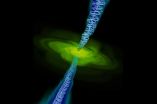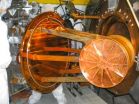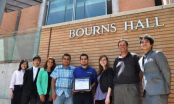(Press-News.org) A team of UCLA researchers has identified a new gene involved in Parkinson's disease, a finding that may one day provide a target for a new drug to prevent and potentially even cure the debilitating neurological disorder.
Parkinson's disease is the second most common neurodegenerative disorder after Alzheimer's disease, and there is no cure for the progressive and devastating illness. About 60,000 Americans are diagnosed with Parkinson's disease each year. It is estimated that as many as 1 million Americans live with Parkinson's disease, which is more than the number of people diagnosed with multiple sclerosis, muscular dystrophy and Lou Gehrig's disease combined.
In Parkinson's disease, multiple neurons in the brain gradually break down or die. This leads to the movement impairments, such as tremor, rigidity, slowness in movement and difficulty walking, as well as depression, anxiety, sleeping difficulties and dementia, said Dr. Ming Guo, the study team leader, associate professor of neurology and pharmacology and a practicing neurologist at UCLA.
A handful of genes have been identified in inherited cases of Parkinson's disease. Guo's team was one of two groups worldwide that first reported in 2006 in the journal Nature that two of these genes, PTEN-induced putative kinase 1 (PINK1) and PARKIN, act together to maintain the health of mitochondria – the power house of the cell that is important in maintaining brain health. Mutations in these genes lead to early-onset Parkinson's disease.
Guo's team has further shown that when PINK1 and PARKIN are operating correctly, they help maintain the regular shape of healthy mitochondria and promote elimination of damaged mitochondria. Accumulation of unhealthy or damaged mitochondria in neurons and muscles ultimately results in Parkinson's disease.
In this study, the team found that the new gene, called MUL1 (also known as MULAN and MAPL), plays an important role in mediating the pathology of the PINK1 and PARKIN. The study, performed in fruit flies and mice, showed that providing an extra amount of MUL1 ameliorates the mitochondrial damage due to mutated PINK/PARKIN, while inhibiting MUL1 in mutant PINK1/PARKIN exacerbates the damage to the mitochondria. In addition, Guo and her collaborators found that removing MUL1 from mouse neurons of the PARKIN disease model results in unhealthy mitochondria and degeneration of the neurons.
The five-year study appears June 4, 2014, in eLife, a new, open access scientific journal for groundbreaking biomedical and life research sponsored by the Howard Hughes Medical Institute (United States), the Wellcome Trust (United Kingdom) and Max Plank Institutes (Germany).
"We are very excited about this finding," Guo said. "There are several implications to this work, including that MUL1 appears to be a very promising drug target and that it may constitute a new pathway regulating the quality of mitochondria."
Guo characterized the work as "a major advancement in Parkinson's disease research."
"We show that MUL1 dosage is key and optimizing its function is crucial for brain health and to ward off Parkinson's disease," she said. "Our work proves that mitochondrial health is of central importance to keep us from suffering from neurodegeneration. Further, finding a drug that can enhance MUL1 function would be of great benefit to patients with Parkinson's disease."
Going forward, Guo and her team will test these results in more complex organisms, hoping to uncover additional functions and mechanisms of MUL1. Additionally, the team will perform small molecule screens to help identify potential compounds that specifically target MUL1. Further, they will examine if mutations in MUL1 exist in some patients with inherited forms of Parkinson's.
INFORMATION:
The study, collaboration between the Guo lab and Dr. Zuhang Sheng from the National Institute of Health, was supported by the National Institute of Aging (R01, K02), National Institute of Neurological Disorders and Stroke (EUREKA award), Ellison Medical Foundation Senior Scholar Award, McKnight Neuroscience Foundation, the Klingenstein Foundation, the American Parkinson's Disease Association and the Glenn Family Foundation.
The UCLA Department of Neurology encompasses more than 26 disease-related research programs. This includes all of the major categories of neurological diseases and methods, encompassing neurogenetics and neuroimaging, as well as health services research. The 140 faculty members of the department are distinguished scientists and clinicians who have been ranked No. 1 in National Institutes of Health funding since 2002. The department is dedicated to understanding the human nervous system and improving the lives of people with neurological diseases, focusing on three key areas: patient/clinical care, research and education.
UCLA researchers identify new gene involved in Parkinson's disease
Finding that may result in new treatments for the debilitating disorder
2014-06-04
ELSE PRESS RELEASES FROM THIS DATE:
Drones give farmers an eye in the sky to check on crop progress
2014-06-04
CHAMPAIGN, Ill. — This growing season, crop researchers at the University of Illinois are experimenting with the use of drones – unmanned aerial vehicles – on the university's South Farms.
Dennis Bowman, a crop sciences educator with U. of I. Extension, is using two drones to take aerial pictures of crops growing in research plots on the farms. He presented his findings to farmers and other researchers at the 2014 Ford / Iroquois County Agronomy Day meeting.
Bowman intentionally made mistakes on one test plot – "areas where we didn't apply enough nitrogen fertilizer, ...
Increase in number of total knee replacement surgeries, especially in younger adults, linked to obesity
2014-06-04
ROSEMONT, Ill.─The number of total knee replacement (TKR) surgeries more than tripled between 1993 and 2009, while the number of total hip replacements (THR) doubled during the same time period. A study appearing in the June Journal of Bone and Joint Surgery (JBJS) found that an increase in the prevalence of ovrweight and obesity in the U.S. accounted for 95 percent of the higher demand for knee replacements, with younger patients affected to a greater degree.
"We observed that growth of knee replacement volumes was far outpacing that of hip replacements and were ...
Surprisingly strong magnetic fields challenge black holes' pull
2014-06-04
A new study of supermassive black holes at the centers of galaxies has found magnetic fields play an impressive role in the systems' dynamics. In fact, in dozens of black holes surveyed, the magnetic field strength matched the force produced by the black holes' powerful gravitational pull, says a team of scientists from the U.S. Department of Energy's Lawrence Berkeley National Laboratory (Berkeley Lab) and Max Planck Institute for Radio Astronomy (MPIfR) in Bonn, Germany. The findings are published in this week's issue of Nature.
"This paper for the first time systematically ...
No evidence of the double nature of neutrinos
2014-06-04
Neutrinos are tiny, neutral elementary particles that, contrary to the standard model of physics, have been proven to have mass. One possible explanation for this mass could be that neutrinos are their own antiparticles, so-called Majorana particles.
Though experimental evidence for this is still lacking, many theoretical extensions of the standard model of physics predict the Majorana nature of neutrinos. If this hypothesis proves to be true, many previously unanswered questions about the origin of our universe and the origin of matter could be answered.
650 meters ...
NASA sees Depression Boris mOVING over Mexico with heavy rainfall
2014-06-04
Tropical Depression 2E strengthened into Tropical Storm Boris briefly on June 3 before making landfall in southern Mexico and weakening into a depression. While Boris was building to tropical storm strength, NASA's Aqua and TRMM satellites passed overhead identifying heavy rainfall and the extent of the storm.
On June 3 at 19:15 UTC (3:15 p.m. EDT) the Moderate Resolution Imaging Spectroradiometer (MODIS) instrument aboard NASA's Aqua satellite captured a visible image of Tropical Storm Boris over Central America. Boris appeared circular in the imagery and its clouds ...
Scientist uses fossils to prove historic Ohio millstones have French origins
2014-06-04
Cleveland . . . A geologist studied fossils to confirm that stones used in 19th century Ohio grain mills originated from France. Fossils embedded in these millstones were analyzed to determine that stones known as French buhr were imported from regions near Paris, France, to Ohio in the United States.
Dr. Joseph Hannibal, curator of invertebrate paleontology at The Cleveland Museum of Natural History, was lead author on research published in the Society for Sedimentary Geology journal PALAIOS.
The study documents a technique that uses fossils to definitively distinguish ...
Cleaning the air with roof tiles
2014-06-04
RIVERSIDE, Calif. (http://www.ucr.edu) — A team of University of California, Riverside's Bourns College of Engineering students created a roof tile coating that when applied to an average-sized residential roof breaks down the same amount of smog-causing nitrogen oxides per year as a car driven 11,000 miles.
They calculated 21 tons of nitrogen oxides would be eliminated daily if tiles on one million roofs were coated with their titanium dioxide mixture. They also calculated it would cost only about $5 for enough titanium dioxide to coat an average-sized residential roof.
That ...
Mayo Clinic researchers decode how the brain miswires, possibly causing ADHD
2014-06-04
JACKSONVILLE, Fla. — Neuroscientists at Mayo Clinic in Florida and at Aarhus University in Denmark have shed light on why neurons in the brain's reward system can be miswired, potentially contributing to disorders such as attention deficit hyperactivity disorder (ADHD).
They say findings from their study, published online today in Neuron, may increase the understanding of underlying causes of ADHD, potentially facilitating the development of more individualized treatment strategies.
The scientists looked at dopaminergic neurons, which regulate pleasure, motivation, ...
GW Cancer Institute conducts survey on moving toward quality patient-centered care
2014-06-04
WASHINGTON (June 4, 2014) — In order to meet new cancer program accreditation standards, institutions have placed new focus on patient navigation, psychosocial distress screening, and survivorship care plans. Recently published research by the George Washington University (GW) Cancer Institute found these new programs are experiencing "growing pains." The results of a nationwide survey conducted by the GW Cancer Institute and reviewed in the Journal of Oncology Navigation and Survivorship, found that health care professionals could most benefit from greater evaluation of ...
Hemorrhagic fevers can be caused by body's antiviral interferon response
2014-06-04
LA JOLLA, CA—June 4, 2014— Hemorrhagic fevers caused by Lassa, dengue and other viruses affect more than one million people annually and are often fatal, yet scientists have never understood why only some virus-infected people come down with the disease and others do not.
But now, virologists and immunologists at The Scripps Research Institute (TSRI) have found a major clue to the mystery of "hemorrhagic fever" syndromes. In findings reported this week in an Early Edition of the Proceedings of the National Academy of Sciences, the team showed that Interferon Type I (IFN-I) ...
LAST 30 PRESS RELEASES:
Membrane magic: FAMU-FSU researchers repurpose fuel cells membranes for new applications
UN Member States pledge to increase access to diagnosis and inhaled medicines for the 480 million people living with COPD
Combination therapy shows potential to treat pediatric brain cancer ATRT
Study links seabird nesting to shark turf wars in Hawai‘i
Legal sports betting linked to sharp increases in violent crime, study finds
Breakthrough AI from NYUAD speeds up discovery of life-supporting microbes
New Eva Mayr-Stihl Foundation funding initiative boosts research at University of Freiburg on adaptation of forests to global change
The perfect plastic? Plant-based, fully saltwater degradable, zero microplastics
Bias in data may be blocking AI’s potential to combat antibiotic resistance
Article-level metrics would provide more recognition to most researchers than journal-level metrics
Satiety’s little helper: Protein that supports appetite regulating protein identified
UF dives deep into predicting storm damage with computer models
A stormy ocean voyage yields insights on the global carbon cycle
Scientists identify first non-coding gene that controls cell size
Demonstration of altermagnetism in RuO₂ thin films -- A new magnetic material for the AI era
Penn researchers awarded $25M to conduct trial using smartphones to fight heart disease
PCORI awards funding for new patient-centered healthcare research
Exploring the origins of the universe: 145 low-noise amplifiers complete ALMA telescopes
Empress cicada wings help illuminate molecular structure
Using sound waves to detect helium
Time burden in patients with metastatic breast and ovarian cancer from clinic and home demands
Researchers discover bias in AI models that analyze pathology samples
Scientists ID potential way to prevent brain injuries from triggering Alzheimer's
MASTER 2nd Open Call: Execution period kick-off
Algae for health in food and pharma
Advanced microrobots driven by acoustic and magnetic fields for biomedical applications
Chicago health information leader recognized for raising CPR readiness and blood pressure awareness
The Intimate Animal, a new book from Kinsey Institute Executive Director Dr. Justin Garcia
When blue-collar workers lose union protection, they try self-employment
New video dataset to advance AI for health care
[Press-News.org] UCLA researchers identify new gene involved in Parkinson's diseaseFinding that may result in new treatments for the debilitating disorder







